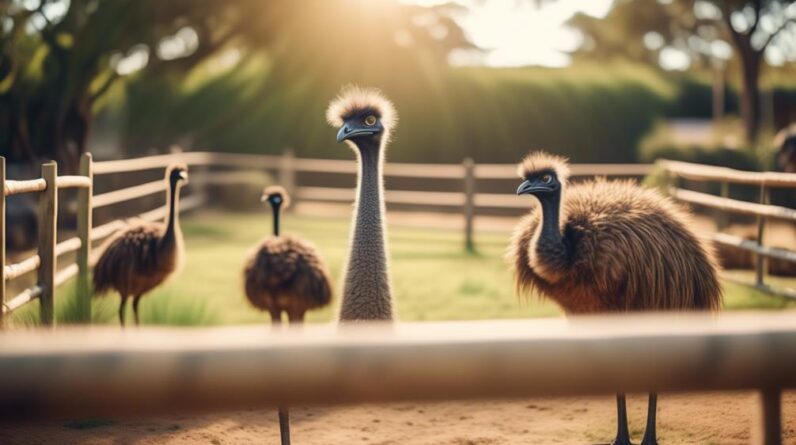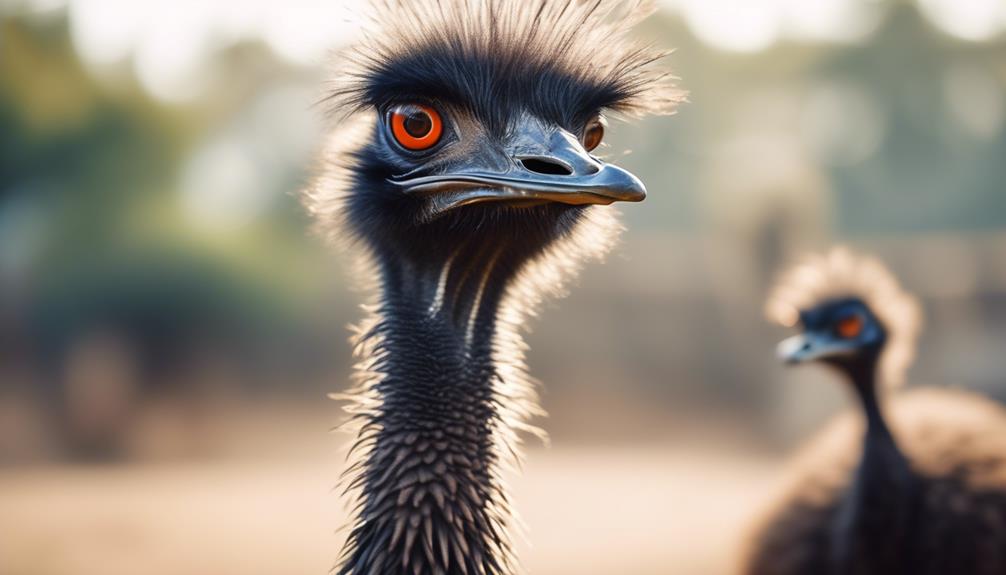
Did you know that emus are the second-largest living birds in the world, reaching heights of up to 6.2 feet?
If you're considering breeding these fascinating creatures, there are several key factors to consider. From selecting healthy emus to creating the ideal breeding environment, timing the emu breeding season, and exploring different breeding techniques, there is a wealth of essential advice to help you navigate the world of emu breeding.
In this discussion, we will explore the best practices and expert tips to ensure a successful and fulfilling experience. Whether you're a seasoned emu breeder or just starting out, there's always something new to learn that could make a significant difference in your emu breeding journey.
Selecting Healthy Emus

Are you wondering how to select healthy emus for breeding? When it comes to breeding emus, it's crucial to choose healthy individuals that will ensure the success of your breeding program. To do this, you need to consider certain emu selection criteria and perform a thorough emu health assessment.
One of the key emu selection criteria is the physical appearance of the bird. Look for emus that have a strong and well-built body structure, as this indicates good health and genetic potential. Check for any signs of deformities, such as crooked legs or misshapen beaks, as these can be indicators of underlying health issues.
Additionally, observe the emu's behavior and temperament. Select emus that exhibit calm and friendly behavior, as this will make handling and breeding them easier. Aggressive or overly timid emus may not be suitable for breeding purposes.
Conducting a comprehensive emu health assessment is vital to ensure that the selected birds are free from any diseases or infections. This assessment should include a thorough physical examination, checking for any signs of illness or injury, and conducting tests for common emu diseases, such as avian influenza or Newcastle disease.
Creating the Right Breeding Environment
To create the optimal breeding environment for emus, it is essential to carefully consider factors such as temperature, lighting, and space requirements. Emus are sensitive to temperature variations, especially during the breeding season. Maintaining a consistent temperature within the breeding enclosure is crucial for successful breeding. The ideal temperature range for emus is between 77°F and 86°F (25°C and 30°C).
Proper temperature regulation can be achieved through the use of heating and cooling systems in the breeding enclosure. These systems can be automated to ensure that the temperature remains within the desired range at all times. It is important to monitor the temperature regularly and make adjustments as necessary to provide a comfortable environment for the emus.
In addition to temperature, lighting also plays a significant role in emu breeding. Providing a suitable lighting schedule simulating natural daylight can help regulate the emus' reproductive cycles. A lighting schedule of 12-14 hours of light and 10-12 hours of darkness is recommended.
Furthermore, the breeding enclosure design should also be taken into consideration. Emus require ample space for breeding and nesting. A spacious enclosure allows the emus to move freely and engage in natural mating behaviors. Providing separate nesting areas for each pair of emus ensures privacy and reduces stress during the breeding process.
Consider the following table for a visual representation of the optimal breeding environment for emus:
| Factors | Recommendations |
|---|---|
| Temperature | Maintain a range of 77°F to 86°F (25°C to 30°C) |
| Lighting | Provide 12-14 hours of light and 10-12 hours of darkness |
| Space requirements | Ensure ample space for breeding and nesting |
| Breeding enclosure design | Separate nesting areas for each pair of emus |
Emu Breeding Season: Timing and Considerations

Now that you have created the optimal breeding environment for your emus, it's important to understand the timing and considerations of the emu breeding season. Breeding emus successfully requires careful planning and understanding of the best time to initiate the breeding process. Here are four key factors to consider:
- Seasonal Timing: The best time to breed emus is during the spring and summer months when the days are longer and the temperatures are milder. Emus are more likely to mate and lay eggs during this time, as it aligns with their natural breeding patterns.
- Age and Health: Emus reach sexual maturity between the ages of 18 months and 2 years. It's crucial to ensure that both the male and female emus are in good health before attempting to breed them. Regular health checks, proper nutrition, and adequate exercise are essential for successful breeding.
- Pairing Compatibility: Emus are monogamous birds and form long-term partnerships. When selecting breeding pairs, it's important to consider their compatibility. Pairing emus with similar size, temperament, and age can increase the chances of successful breeding.
- Nesting Conditions: Providing suitable nesting conditions is crucial for successful breeding. Emus prefer a quiet and secluded area, preferably covered with vegetation, where they can build their nests. Ensure that the nesting area is clean, spacious, and well-protected from predators.
Understanding the best time and considering these breeding factors will greatly increase the likelihood of successful emu breeding. By providing the right conditions and addressing the specific needs of your emus, you can create a breeding season that promotes healthy and thriving offspring.
Emu Breeding Techniques: Natural Vs. Artificial Insemination
Emu breeding techniques can be classified into two main categories: natural insemination and artificial insemination.
Natural insemination occurs when male emus are allowed to mate with female emus in a natural setting. This method has several benefits. Firstly, it allows for the preservation of the emus' natural behavior and instincts, as they're able to engage in the courtship rituals that are essential for successful breeding. Additionally, natural insemination can lead to improved fertility rates, as the emus' reproductive systems are more likely to function optimally when mating occurs naturally.
On the other hand, artificial insemination involves the collection of semen from male emus and the subsequent introduction of the semen into female emus' reproductive tracts. This technique offers several advantages. Firstly, it allows breeders to control and manage the breeding process more effectively, as they can choose specific males with desirable genetic traits to father the offspring. Additionally, artificial insemination can increase the number of offspring produced from a single male, as his semen can be used to fertilize multiple females. This can be particularly valuable for breeders who are trying to establish or maintain specific genetic lines within their emu populations.
Caring for Emu Chicks: Nutrition and Development

Caring for emu chicks involves providing them with proper nutrition and ensuring their healthy development. Here are some essential tips to help you with this critical task:
- Emu Chick Feeding Schedule: Establishing a consistent feeding schedule is crucial for the healthy growth and development of emu chicks. Feed them a commercial emu starter ration specifically formulated for their nutritional needs. Offer food four times a day for the first two weeks, gradually reducing it to two times a day by the age of six weeks. Ensure a constant supply of clean, fresh water.
- Emu Chick Growth Milestones: Monitor the growth of your emu chicks closely to ensure they're progressing as expected. At two weeks old, they should weigh around 2-3 pounds. By eight weeks, their weight should increase to 15-25 pounds. At six months, emu chicks should weigh around 70-90 pounds. Regularly weigh them to track their growth and adjust their diet accordingly.
- High-Quality Feed: Emu chicks require a balanced diet rich in protein, vitamins, and minerals to support their rapid growth. Provide them with high-quality emu starter feed that contains around 24% protein. Additionally, consider supplementing their diet with fresh greens and insects to promote natural foraging behavior.
- Environmental Enrichment: Emu chicks benefit from environmental enrichment to stimulate their mental and physical development. Provide them with a spacious and clean enclosure that allows room for exercise and exploration. Offer objects such as branches and toys to encourage natural behaviors like pecking and scratching.
Emu Breeding Challenges and Troubleshooting Tips
Breeding emus presents various challenges that may arise during the process, requiring troubleshooting and careful attention to ensure successful reproduction.
One of the primary challenges in emu breeding is maintaining genetic diversity. Emus, like many other animals, are susceptible to inbreeding, which can lead to a decrease in overall health and fertility. To address this challenge, it's crucial to have a well-planned breeding program that focuses on maintaining a diverse gene pool.
To ensure genetic diversity in emu breeding, it's essential to introduce unrelated birds into the breeding population regularly. This can be achieved by purchasing emus from different breeders or participating in genetic exchange programs. By doing so, you can prevent the negative effects of inbreeding and promote a healthier and more robust population.
Another challenge that may arise in emu breeding is the identification of reproductive issues. Some emus may experience difficulty in mating or producing fertile eggs. In such cases, it's important to troubleshoot the problem and seek veterinary assistance if necessary. Factors such as age, health, and nutrition can all affect reproductive success in emus, so it's crucial to provide optimal conditions for breeding.
Frequently Asked Questions
How Long Does It Take for Emus to Reach Sexual Maturity?
It usually takes emus around 18-24 months to reach sexual maturity. Factors such as nutrition, environment, and genetics can affect this process. Proper emu breeding techniques can help ensure healthy development and successful reproduction.
Can Emus Breed All Year Round, or Is There a Specific Breeding Season?
Emus can breed all year round, but there are certain factors that can affect their breeding season. These factors include temperature, availability of food, and daylight hours. It's important to understand these factors for successful breeding.
Are There Any Specific Precautions or Considerations to Keep in Mind When Introducing a New Emu to an Existing Breeding Pair?
When introducing a new emu to an existing breeding pair, there are important precautions and considerations to keep in mind. Take your time, ensure proper socialization, and monitor interactions closely to ensure a successful integration.
What Are the Most Common Health Issues or Diseases That Emus Can Experience During the Breeding Process?
During the breeding process, emus can experience common health issues such as respiratory infections, parasites, and nutritional deficiencies. It is essential to provide proper nutrition, regular check-ups, and appropriate medications to ensure their well-being.
Do Emus Require Any Special Supplements or Vitamins During the Breeding Season to Enhance Fertility?
During the breeding season, emus like you may benefit from special supplements or vitamins to enhance fertility. Supplementing emus with the right nutrition can have a positive impact on their reproductive capabilities.
Conclusion
Congratulations! You're now equipped with the best practices and essential advice for breeding emus.
From selecting healthy emus to creating the perfect breeding environment, timing considerations, and choosing between natural and artificial insemination techniques, this article has covered it all.
With proper nutrition and care, you can ensure the healthy development of emu chicks.
Remember, while breeding emus may have its challenges, you're now armed with troubleshooting tips to overcome them.
Get ready to embark on this fascinating journey of emu breeding and watch your flock thrive!





